Zircon U-Pb and Pyrite Re-Os Isotope Geochemistry of ‘Skarn-Type’ Fe-Cu Mineralization at the Shuikoushan Polymetallic Deposit, South China: Implications for an Early Cretaceous Mineralization Event in the Nanling Range
Abstract
1. Introduction
2. Regional Geological Setting
3. Ore Deposit Geology
4. Paragenetic Sequence of Fe-Cu Mineralization
5. Sampling and Analytical Methods
5.1. Sample Collection
5.2. Analytical Methods
5.2.1. Whole-Rock Major and Trace Element Analysis
5.2.2. U-Pb Dating and Trace Elements in Zircon
5.2.3. Zircon Lu-Hf Isotopes
5.2.4. Pyrite Re-Os Dating
6. Results
6.1. Whole-Rock Major and Trace Element Compositions of the No. 3 Granodiorite
6.2. Rare Earth Element and Ti Contents of Zircons
6.3. Zircon U-Pb Geochronology
6.4. Zircon Hf Isotopic Compositions
6.5. Pyrite Re-Os Geochronology
7. Discussion
7.1. Emplacement Age and Source of the No. 3 Concealed Granodiorite
7.2. Timing and Source of Fe-Cu Mineralization in the Shuikoushan Deposit
7.3. A Genetic Model of Fe-Cu Mineralization in the Shuikoushan Deposit
7.4. Implication for the Early Cretaceous Mineralization Event in the Nanling Range
8. Conclusions
- (1)
- The No. 3 granodiorite was emplaced at 153.7 ± 0.58 Ma, similar to other granitoids in the Shuikoushan ore field and Nanling Range. Fe-Cu mineralization in the deposit formed at 140 ± 11 Ma, much younger than the No. 3 granodiorite. The younger Fe-Cu mineralization is interpreted as being related to injection of post-magmatic hydrothermal fluids.
- (2)
- The Late Paleoproterozoic basement in the Shuikoushan ore field provides rock-forming materials and ore-forming metals of granodiorites and Fe-Cu mineralization in this region.
- (3)
- The Early Cretaceous may also be an important mineralization epoch in the Nanling Range.
Author Contributions
Funding
Data Availability Statement
Acknowledgments
Conflicts of Interest
References
- Ma, L.Y.; Lu, Y.F.; Mei, Y.P.; Chen, X.Q. Zircon SHRIMP U-Pb dating of granodiorite from Shuikoushan ore-field, Hunan province and its geological significance. Acta Petrol. Sin. 2006, 22, 2475–2482, (In Chinese with English abstract). [Google Scholar]
- Zuo, C.H.; Lu, R.; Zhao, Z.X.; Xu, Z.W.; Lu, J.J.; Wang, R.C.; Chen, J.Q. Characterization of element geochemistry, LA-ICP-MS zircon U-Pb age, and Hf isotope of granodiorite in the Shuikoushan deposit, Changning, Hunan Province. Geol. Rev. 2014, 60, 811–823, (In Chinese with English abstract). [Google Scholar]
- Li, J.; Zhao, P.P.; Liu, J.G.; Wang, X.C.; Yang Alexandra Wang, G.Q.; Xu, J.F. Reassessment of hydrofluoric acid desilicification in the Carius tube digestion technique for Re-Os isotopic analysis in geological samples. Geostand. Geoanalytical Res. 2015, 39, 17–30. [Google Scholar] [CrossRef]
- Chen, P.B.; Liu, J.S.; Wan, K.Y.; Xu, W.J.; Xiong, F.S.; Ren, Z. Geological characteristics and prospecting criteria of skarn iron poly-metallic deposit related to No. 3 granite intrusion in the Shuikoushan ore field, Hunan. Min. Explor. 2016, 7, 450–455, (In Chinese with English abstract). [Google Scholar]
- Zeng, M.; Zhang, D.; Zhang, Z.; Li, T.; Li, C.; Wei, C. Structural controls on the Lala iron-copper deposit of the Kangdian metallogenic province, southwestern China: Tectonic and metallogenic implications. Ore Geol. Rev. 2018, 97, 35–54. [Google Scholar] [CrossRef]
- Wan, K.Y.; Chen, P.B.; He, C.X.; Liao, C.H.; Zuo, C.H.; Li, Q.S.; Liu, M.H.; Luo, Q.; Xiang, H.L. The Resource Exploration Report of the Shuikoushan polymetallic Deposit in Hunan Province; Team 217 of Hunan Nonferrous Geological Exploration Bureau Internal Report; Hunan Nonferrous Geological Exploration Bureau: Hunan, China, 2015; p. 120. (In Chinese) [Google Scholar]
- Zhen, S.M.; Zhu, X.Y.; Li, Y.S.; Du, Z.Z.; Gong, F.Y.; Gong, X.D.; Qi, F.Y.; Jia, D.L.; Wang, L.L. Zircon U-Pb geochro-nology and Hf isotopic compositions of the monzonite, related to the Xianrenyan Au deposite in Hunan province and its geological significances. J. Jilin Univ. (Earth Sci. Ed.) 2012, 42, 1740–1756, (In Chinese with English abstract). [Google Scholar]
- Zhao, Z.X.; Lu, R.; Zuo, C.H.; Miao, B.H.; Xu, Z.W.; Lu, J.J. Discussion on Hunan province Changning Shuikoushan Pb-Zn ore deposit genesis. Acta Mineral. Sin. 2013, s2, 540–541, (In Chinese with English abstract). [Google Scholar]
- Huang, J.C.; Peng, J.T.; Yang, J.H.; Zhang, B.L.; Xu, C.X. Precise zircon U-Pb and molybdenite Re–Os dating of the Shuikoushan granodiorite-related Pb–Zn mineralization, southern Hunan, south china. Ore Geol. Rev. 2015, 71, 305–317. [Google Scholar] [CrossRef]
- Hua, R.M.; Chen, P.R.; Zhang, W.L.; Liu, X.D.; Lu, J.J.; Lin, J.F.; Yao, J.M.; Qi, H.W.; Zhang, Z.S.; Gu, S.Y. Metallogenic systems related to Mesozoic and Cenozoic granitoids in South China. Sci. China Ser. D. 2003, 46, 816–829. [Google Scholar] [CrossRef]
- Mao, J.W.; Xie, G.Q.; Guo, C.L.; Yuan, S.D.; Cheng, Y.B.; Chen, Y.C. Spatial-temporal distribution of Mesozoic ore deposits in South China and their metallogenic settings. Geol. J.China Univ. 2008, 14, 510–526, (In Chinese with English abstract). [Google Scholar]
- Li, H.Y.; Mao, J.W.; Sun, Y.L.; Zou, X.Q.; He, H.L.; Du, A.D. Re–Os isotopic chronology of the molybdenites in the Shizhuyuan polymetallic tungsten deposit, southern Hunan. Geol. Rev. 1996, 42, 261–271, (In Chinese with English abstract). [Google Scholar]
- Mao, J.W.; Stein, H.; Du, A.D.; Zhou, T.F.; Mei, Y.X.; Li, Y.F.; Zang, W.S.; Li, J.W. Molybdenite Re-Os precise dating for molybdenite from Cu-Au-Mo deposits in the middle-lower reaches of Yangtze River belt and its implications for mineralization. Acta Geol. Sin. 2004, 78, 121–131, (In Chinese with English abstract). [Google Scholar]
- Mao, J.W.; Xie, G.Q.; Li, X.F.; Zhang, C.Q.; Mei, Y.X. Mesozoic large scale mineralization and multiple lithospheric extension in South China. Earth Sci. Front. 2004, 1, 45–55, (In Chinese with English abstract). [Google Scholar]
- Mao, J.W.; Xie, G.Q.; Guo, C.L.; Chen, Y.C. Large-scale W-tin mineralization in the Nanling region, South China: Metallogenic ages and corresponding geodynamic processes. Acta Petrol. Sin. 2007, 23, 2329–2338, (In Chinese with English abstract). [Google Scholar]
- Peng, J.T.; Hu, R.Z.; Bi, X.W.; Dai, T.M.; Li, Z.L.; Li, X.M.; Shuang, Y.; Yuan, S.D.; Liu, S.R. 40Ar/39Ar isotopic dating of tin mineralization in Furong deposit of Hunan Province and its geological significance. Miner. Depos. 2007, 3, 237–248, (In Chinese with English abstract). [Google Scholar]
- Liu, X.F.; Yuan, S.D.; Wu, S.H. Re-Os dating of the molybdenite from the Jinchuantang tin-bismuth deposit in Hunan Province and its geological significance. Acta Petrol. Sin. 2012, 28, 39–51, (In Chinese with English abstract). [Google Scholar]
- Yuan, S.D.; Liu, X.F.; Wang, X.D.; Wu, S.H.; Yuan, Y.B.; Li, X.K.; Wang, T.Z. Geological characteristics and 40Ar-39Ar geochronology of the Hongqiling tin deposit in southern Hunan Province. Acta Petrol. Sin. 2012, 28, 3787–3797, (In Chinese with English abstract). [Google Scholar]
- Yuan, Y.B.; Yuan, S.D.; Chen, C.J.; Huo, R. Zircon U-Pb ages and Hf isotopes of the granitoids in the Huangshaping mining area and their geological significance. Acta Petrol. Sin. 2014, 30, 64–78, (In Chinese with English abstract). [Google Scholar]
- Lu, R.; Xu, Z.W.; Lu, J.J.; Wang, R.C.; Zuo, C.H.; Zhao, Z.X.; Miao, B.H. Genesis of the Shuikoushan Pb-Zn deposite, Changning City, Hunan province. J. Nanjing Univ. (Nat. Sci.) 2013, 49, 732–746, (In Chinese with English abstract). [Google Scholar]
- Walker, R.J.; Carlson, R.W.; Shirey, S.B.; Boyd, F.R. Os, Sr, Nd, and Pb isotope systematics of southern African peridotite xenoliths: Implications for the chemical evolution of subcontinental mantle. Geochim. Cosmochim. Acta 1989, 53, 1583–1595. [Google Scholar] [CrossRef]
- Ruiz, J.; Freydier, C.; McCandless, T.; Chesley, J.; Munizaga, F. Re-Os-Isotope systematics of sulfides from base-metal porphyry and manto-type mineralization in Chile. Int. Geol. Rev. 1997, 39, 317–324. [Google Scholar] [CrossRef]
- Lambert, D.D.; Foster, J.G.; Frick, L.R. Re-Os isotopic systematics of the Voisey’s Bay Ni-Cu-Co magmatic ore system, Labrador, Canada. Lithos 1999, 47, 69–88. [Google Scholar] [CrossRef]
- Kirk, J.D.; Ruiz, J.; Kesler, S.E.; Simon, A.; Muntean, J.L. Re-Os age of the pueblo Viejo epithermal deposit, Dominican Republic. Econ. Geol. 2014, 109, 503–512. [Google Scholar] [CrossRef]
- Mo, Z.S.; Ye, B.D.; Pan, W.Z.; Wan, S.N. Geology of Granites in Nanling Range; Geological Publishing House: Beijing, China, 1980; pp. 1–363. (In Chinese) [Google Scholar]
- Zhou, X.; Sun, T.; Shen, W.; Shu, L.; Niu, A.Y. Petrogenesis of Mesozoic granitoids and volcanic rocks in South China: A response to tectonic evolution. Episodes 2006, 29, 26–33. [Google Scholar] [CrossRef] [PubMed]
- Xu, K.Q.; Ding, Y. Viewpoints on the genesis and classification for the tungsten deposits in China. Geol. Rev. 1983, 3, 305–325, (In Chinese with English abstract). [Google Scholar]
- Jiang, S.Y.; Zhao, K.D.; Jiang, Y.H.; Ling, H.F.; Ni, P. New type of tin w element and isotope geochemistry. Acta Pet. Sin. 2006, 22, 2509–2516, (In Chinese with English abstract). [Google Scholar]
- Jiang, S.Y.; Zhao, K.D.; Jiang, Y.H.; Dai, B.Z. Characteristics and genesis of Mesozoic A type granites and associated mineral deposits in the southern Hunan and northern Guangxi provinces along the Shi-Hang Belt, South China. Geol. J. China Univ. 2008, 14, 496–509, (In Chinese with English abstract). [Google Scholar]
- Yang, J.-H.; Peng, J.-T.; Zheng, Y.-F.; Hu, R.-Z.; Bi, X.-W.; Zhao, J.-H.; Huang, J.-C.; Zhang, B.-L. Petrogenesis of the Mesozoic Shuikoushan peraluminous I-type granodioritic intrusion in Hunan Province, South China: Middle–lower crustal reworking in an extensional tectonic setting. J. Asian Earth Sci. 2016, 123, 224–242. [Google Scholar] [CrossRef]
- Peng, J.; Zhou, M.-F.; Hu, R.; Shen, N.; Yuan, S.; Bi, X.; Du, A.; Qu, W. Precise molybdenite Re–Os and mica Ar–Ar dating of the Mesozoic Yaogangxian tungsten deposit, central Nanling district, South China. Miner. Deposita 2006, 41, 661–669. [Google Scholar] [CrossRef]
- Peng, J.T.; Hu, R.Z.; Yuan, S.D.; Bi, X.W.; Shen, N.P. The time ranges of granitoid emplacement and related nonferrous metallic mineralization in southern Hunan. Geol. Rev. 2008, 54, 617–625, (In Chinese with English abstract). [Google Scholar]
- Mao, J.W.; Cheng, Y.B.; Chen, M.H.; Franco, P. Major types and time-space distribution of Mesozoic ore deposits in South China and their geodynamic settings. Miner. Depos. 2013, 48, 267–294. [Google Scholar]
- Li, N.Q.; Peng, C. Shuikoushan Lead-Zinc-Gold-Silver Orefield, Hunan, China; Seismological Publishing House: Beijing, China, 1996; pp. 1–103. (In Chinese) [Google Scholar]
- Lu, Y.F.; Ma, L.Y.; Qu, W.J.; Mei, Y.P.; Chen, X.Q. U-Pb and Re-Os isotope geochronology of Baoshan Cu-Mo polymetallic ore deposit in Hunan province. Acta Petrol. Sin. 2006, 22, 2483–2492, (In Chinese with English abstract). [Google Scholar]
- Chen, J.F.; Jahn, B.M. Crustal evolution of southeastern China: Nd and Sr isotopic evidence. Tectonophysics 1998, 284, 101–133. [Google Scholar] [CrossRef]
- Yu, H.X.; Liu, J.Y. The characteristic and petrogenesis of the felsic-intermediate subvolcanic complex in the Shuikoushan orefield. Geotecton. Et. Metallog. 1997, 1, 32–40, (In Chinese with English abstract). [Google Scholar]
- Elhlou, S.; Belousova, E.; Griffin, W.L.; Pearson, N.J.; O’Reilly, S.Y. Trace element and isotopic composition of GJ-red zircon standard by laser ablation. Geochim. Cosmochim. Acta 2006, 70, 158. [Google Scholar] [CrossRef]
- Sláma, J.; Košler, J.; Condon, D.J.; Crowley, J.L.; Gerdes, A.; Hanchar, J.M.; Horstwood, M.S.; Morris, G.A.; Nasdala, L.; Norberg, N.; et al. Plešovice zircon—A new natural reference material for U–Pb and Hf isotopic microanalysis. Chem. Geol. 2008, 249, 1–35. [Google Scholar] [CrossRef]
- Liu, Y.; Gao, S.; Hu, Z.; Gao, C.; Zong, K.; Wang, D. Continental and oceanic crust recycling-induced melt-peridotite interactions in the Trans-North China Orogen: U-Pb dating, Hf isotopes and trace elements in zicons from mantle xenoliths. J. Pet. 2009, 51, 537–571. [Google Scholar] [CrossRef]
- Ludwing, K.R. User’s Manual for Isoplot 3.75: A Geochronological Toolkit for Microsoft Excel. Berkeley Geochronological Center Special Publication No. 5: Berkeley, CA, USA. 2012. Available online: https://www.geocalculate.com/wp-content/uploads/2019/10/Isoplot3_75-4_15manual.pdf (accessed on 30 January 2012).
- Wu, F.-Y.; Yang, Y.-H.; Xie, L.-W.; Yang, J.-H.; Xu, P. Hf isotopic compositions of the standard zircons and baddeleyites used in U–Pb geochronology. Chem. Geol. 2006, 234, 105–126. [Google Scholar] [CrossRef]
- Yuan, H.-L.; Gao, S.; Dai, M.-N.; Zong, C.-L.; Günther, D.; Fontaine, G.H.; Liu, X.-M.; Diwu, C. Simultaneous determinations of U–Pb age, Hf isotopes and trace element compositions of zircon by excimer laser-ablation quadrupole and multiple-collector ICP-MS. Chem. Geol. 2008, 247, 100–118. [Google Scholar] [CrossRef]
- Li, Q.L.; Li, X.H.; Liu, Y.; Tang, G.Q.; Yang, J.H.; Zhu, W.G. Precise U-Pb and Pb-Pb dating of Phanerozoic baddeleyite by SIMS with oxygen flooding technique. J. Anal. At. Spectrom. 2010, 25, 1107–1113. [Google Scholar] [CrossRef]
- Wu, F.Y.; Li, X.H.; Zheng, Y.F.; Gao, S. Lu-Hf isotopic systematics and their applications in petrology. Acta Petrol. Sin. 2007, 23, 185–220, (In Chinese with English abstract). [Google Scholar]
- Rubatto, D.; Gebauer, D. Use of cathodoluminescence for U-Pb zircon dating by ion microprobe: Some examples from the Western Alps. In Cathodoluminescence in Geosciences; Pagel, M., Barbin, V., Blanc, P., Ohnenstetter, D., Eds.; Springer: Berlin, Germany, 2000; pp. 373–400. [Google Scholar]
- Griffin, W.L.; Pearson, N.J.; Belousova, E.; Jackson, S.E.; van Achterbergh, E.; O’Reilly, S.Y.; Shee, S.R. The Hf isotope composition of cratonic mantle: LA-MC-ICPMS analysis of zircon megacrysts in kimberlites. Geochim. Cosmochim. Acta 2000, 64, 133–147. [Google Scholar] [CrossRef]
- Cohen, A.S.; Waters, F.G. Separation of osmium from geological materials by solvent extraction for analysis by thermal ionisation mass spectrometry. Anal. Chim. Acta 1996, 332, 269–275. [Google Scholar] [CrossRef]
- Nier, A.O. The Isotopic Constitution of Osmium. Phys. Rev. 1937, 52, 885. [Google Scholar] [CrossRef]
- Li, J.; Xu, J.F.; Suzuki Katsuhiko He, B.; Xu, Y.G.; Ren, Z.Y. Os, Nd and Sr isotope and trace element geochemistry of the Muli picrites: Insights into the mantle source of the Emeishan Large Igneous Province. Lithos 2010, 119, 108–122. [Google Scholar] [CrossRef]
- Li, J.; Jiang, X.Y.; Xu, J.F.; Zhong, L.F.; Wang, X.C.; Wang, G.Q.; Zhao, P.P. Determination of platinum-group elements and Re-Os isotopes using ID-ICP-MS and N-TIMS from a single digestion after two-stage column separation. Geostand. Geoanalytical Res. 2014, 38, 37–50. [Google Scholar] [CrossRef]
- Sun, S.-S.; McDonough, W.F. Chemical and isotopic systematics of oceanic basalts: Implications for mantle composition and processes. Geol. Soc. London. Spéc. Publ. 1989, 42, 313–345. [Google Scholar] [CrossRef]
- Watson, E.B.; Wark, D.A.; Thomas, J.B. Crystallization thermometers for zircon and rutile. Contrib. Miner. Pet. 2006, 151, 413–433. [Google Scholar] [CrossRef]
- Micheletti, F.; Fornelli, A.; Piccarreta, G.; Barbey, P.; Tiepolo, M. The basement of Calabria (southern Italy) within the context of the Southern European Variscides: LA-ICPMS and SIMS U–Pb zircon study. Lithos 2008, 104, 1–11. [Google Scholar] [CrossRef]
- Ludwig, K.R. Isoplot/Ex: A geochronological toolkit for Microsoft Excel; Berkeley Geochronology Center Special Publication: Version 3.0; Berkeley Geochronology Center: Berkeley, CA, USA, 1999; p. 49. Available online: https://searchworks.stanford.edu/view/6739593 (accessed on 27 August 2003).
- Hoskin, P.O. Trace-element composition of hydrothermal zircon and the alteration of Hadean zircon from the Jack Hills, Australia. Geochim. Cosmochim. Acta 2005, 69, 637–648. [Google Scholar] [CrossRef]
- Belousova, E.A.; Griffin, W.L.; O’ Reilly, S.Y.; Fisher, N.L. Igneous zircon: Trace element composition as an indicator of source rock type. Contrib. Miner. Pet. 2002, 143, 602–622. [Google Scholar] [CrossRef]
- Hermann, J.; Rubatto, D.; Korsakov, A.; Shatsky, V.S. Multiple zircon growth during fast exhumation of diamondiferous, deeply subducted continental crust (Kokchetav Massif, Kazakhstan). Contrib. Miner. Pet. 2001, 141, 66–82. [Google Scholar] [CrossRef]
- Bouvier, A.; Vervoort, J.D.; Patchett, P.J. The Lu-Hf and Sm-Nd isotopic composition of CHUR: Constraints from unequilibrated chondrites and implications for the bulk composition of terrestrial planets. Earth Planet. Sci. Lett. 2008, 273, 48–57. [Google Scholar] [CrossRef]
- Huang, J.C. Geochronology and Petrogenetic-Metallogenic Mechanisms in the Shuikoushan Pb-Zn-Au Deposit; University of Chinese Academy of Sciences: Hunan, China, 2016; (In Chinese with English abstract). [Google Scholar]
- Mao, J.W.; Pirajno, F.; Xiang, J.F.; Gao, J.J.; Ye, H.S.; Li, Y.F.; Guo, B.J. Mesozoic molybdenum deposits in the east Qinling–Dabie orogenic belt: Characteristics and tectonic settings. Ore Geol. Rev. 2011, 43, 264–293. [Google Scholar] [CrossRef]
- Li, S.D.; Wang, Z.G.; Wang, K.Y.; Cai, W.Y.; Peng, D.W.; Xiao, L.; Li, J. Re–Os Pyrite geochronological evidence of three mineralization styles within the Jinchang Gold Deposit, Yanji–Dongning Metallogenic Belt, Northeast China. Minerals 2018, 8, 448. [Google Scholar] [CrossRef]
- Zhang, Y.; Lin, G.; Roberts, P.; Ord, A. Numerical modelling of deformation and fluid flow in the Shuikoushan district, Hunan Province, South China. Ore Geol. Rev. 2007, 31, 261–278. [Google Scholar] [CrossRef]
- Walker, R.; Morgan, J.; Horan, M.; Czamanske, G.; Krogstad, E.; Fedorenko, V.; Kunilov, V. Re-Os isotopic evidence for an enriched-mantle source for the Noril’sk-type, ore-bearing intrusions, Siberia. Geochim. Cosmochim. Acta 1994, 58, 4179–4197. [Google Scholar] [CrossRef]
- Foster, J.G.; Lambert, D.D.; Frick, L.R.; Maas, R. Re-Os isotopic evidence for genesis of Archaean nickel ores from uncontaminated komatiites. Nature 1996, 382, 703–706. [Google Scholar] [CrossRef]
- Mao, J.W.; Wang, Z.L. A preliminary study on time limits and geodynamic setting of large-scale metallogeny in east China. Miner. Depos. 2000, 9, 289–299, (In Chinese with English abstract). [Google Scholar]
- Stein, H.J.; Morgan, J.W.; Schersten, A. Re-Os Dating of Low-Level Highly Radiogenic (LLHR) Sulfides:The Harnas Gold Deposit, Southwest Sweden, Records Continental-Scale TectonicEvents. Econ. Geol. 2000, 95, 1657–1671. [Google Scholar] [CrossRef]
- Arne, D.; Bierlein, F.P.; Morgan, J.W.; Stein, H.J. Re-Os dating of sulfides associated with gold mineralization in central Victoria, Australia. Econ. Geol. 2001, 96, 1455–1459. [Google Scholar] [CrossRef]
- Shirey, S.B.; Walker, R.J. The Re-Os isotope system in cosmochemistry and high-temperature geochemistry. Annu. Rev. Earth Planet. Sci. 1998, 26, 423–500. [Google Scholar] [CrossRef]
- Palmer, M.R.; Turekian, K.K. 187Os/186Os in marine manganese nodules and the constraints on the crustal geochemistries of rhenium and osmium. Nat. Cell Biol. 1986, 319, 216–220. [Google Scholar] [CrossRef]
- Lei, Z.H.; Chen, F.W.; Chen, Z.H.; Xu, Y.M.; Gong, S.Q.; Li, H.Q.; Mei, Y.P.; Qu, W.J.; Wang, D.H. Petrogenetic and metallogenic age determination of the Huangshaping Pb-Zn polymetallic deposit and its geological significance. Acta Geosci. Sin. 2010, 31, 532–540, (In Chinese with English abstract). [Google Scholar]
- Xie, Y.C.; Lu, J.J.; Ma, D.S.; Zhang, R.Q.; Gao, J.F.; Yao, Y. Origin of granodiorite porphyry and mafic microgranular enclave in the Baoshan Pb-Zn polymetallic deposit, southern Hunan Province: Zircon U-Pb chronological, geochemical and Sr-Nd-Hf isotopic constraints. Acta Petrol. Sin. 2013, 29, 4186–4214. [Google Scholar]
- Lu, Y.Y.; Fu, J.M.; Cheng, S.B.; Liu, S.S.; Li, C.B.; Zhang, L.G.; Ma, L.Y. Rock-Forming and Ore-Forming Ages of Tongshanling Cu Polymetallic Ore-Field in Southern Hunan Province. Geotecton. Et. Metallog. 2015, 39, 1061–1071, (In Chinese with English abstract). [Google Scholar]
- Li, S.T.; Wang, J.B.; Zhu, X.Y.; Li, C. Re-Os dating of molybdenite and S isotope analysis of the Yaogangxian W polymetallic deposits in Hunan province and their geological significance. Geoscience 2011, 25, 228–235, (In Chinese with English abstract). [Google Scholar]
- Xuan, Y.S.; Yuan, S.D.; Yuan, Y.B.; Mi, J.R. Zircon U-Pb age, geochemistry and Petrogenesis of Jianfengling pluton in southern Hunan Province. Miner. Depos. 2014, 33, 1379–1390. [Google Scholar]
- Yao, J.; Hua, R.; Qu, W.; Qi, H.; Lin, J.; Du, A. Re-Os isotope dating of molybdenites in the Huangshaping Pb-Zn-W-Mo polymetallic deposit, Hunan Province, South China and its geological significance. Sci. China Ser. D Earth Sci. 2007, 50, 519–526. [Google Scholar] [CrossRef]
- Hua, R.M.; Li, G.L.; Zhang, W.L.; Hu, D.Q.; Chen, P.R.; Chen, W.F.; Wang, X.D. A tentative discussion on differences between large-scale W and tin mineralizations in South China. Min. Depos. 2010, 29, 9–23, (In Chinese with English abstract). [Google Scholar]
- Xiong, Y.-Q.; Shao, Y.-J.; Cheng, Y.; Jiang, S.-Y. Discrete Jurassic and Cretaceous Mineralization Events at the Xiangdong W(-Sn) Deposit, Nanling Range, South China. Econ. Geol. 2020, 115, 385–413. [Google Scholar] [CrossRef]
- Huang, L.; Jiang, S. Highly fractionated S-type granites from the giant Dahutang tungsten deposit in Jiangnan orogen, southeast China: Geochronology, Petrogenesis and their relationship with W-mineralization. Lithos 2014, 202, 207–226. [Google Scholar] [CrossRef]
- Pan, X.; Hou, Z.; Li, Y.; Chen, G.; Zhao, M.; Zhang, T.; Zhang, C.; Wei, J.; Kang, C. Dating the giant Zhuxi W–Cu deposit (Taqian–Fuchun Ore Belt) in South China using molybdenite Re–Os and muscovite Ar–Ar system. Ore Geol. Rev. 2017, 86, 719–733. [Google Scholar] [CrossRef]
- Liu, P.; Mao, J.; Pirajno, F.; Jia, L.; Zhang, F.; Li, Y. Ore genesis and geodynamic setting of the Lianhuashan porphyry tungsten deposit, eastern Guangdong Province, SE China: Constraints from muscovite 40Ar-39Ar and zircon U-Pb dating and Hf isotopes. Miner. Depos. 2017, 5, 1–18. [Google Scholar] [CrossRef]
- Liu, P.; Mao, J.; Santosh, M.; Xu, L.; Zhang, R.; Jia, L. The Xiling Sn deposit, eastern Guangdong Province, southeast China: A new genetic model from 40Ar/39Ar muscovite and U-Pb cassiterite and zircon geochronology. Econ. Geol. 2018, 113, 511–530. [Google Scholar] [CrossRef]
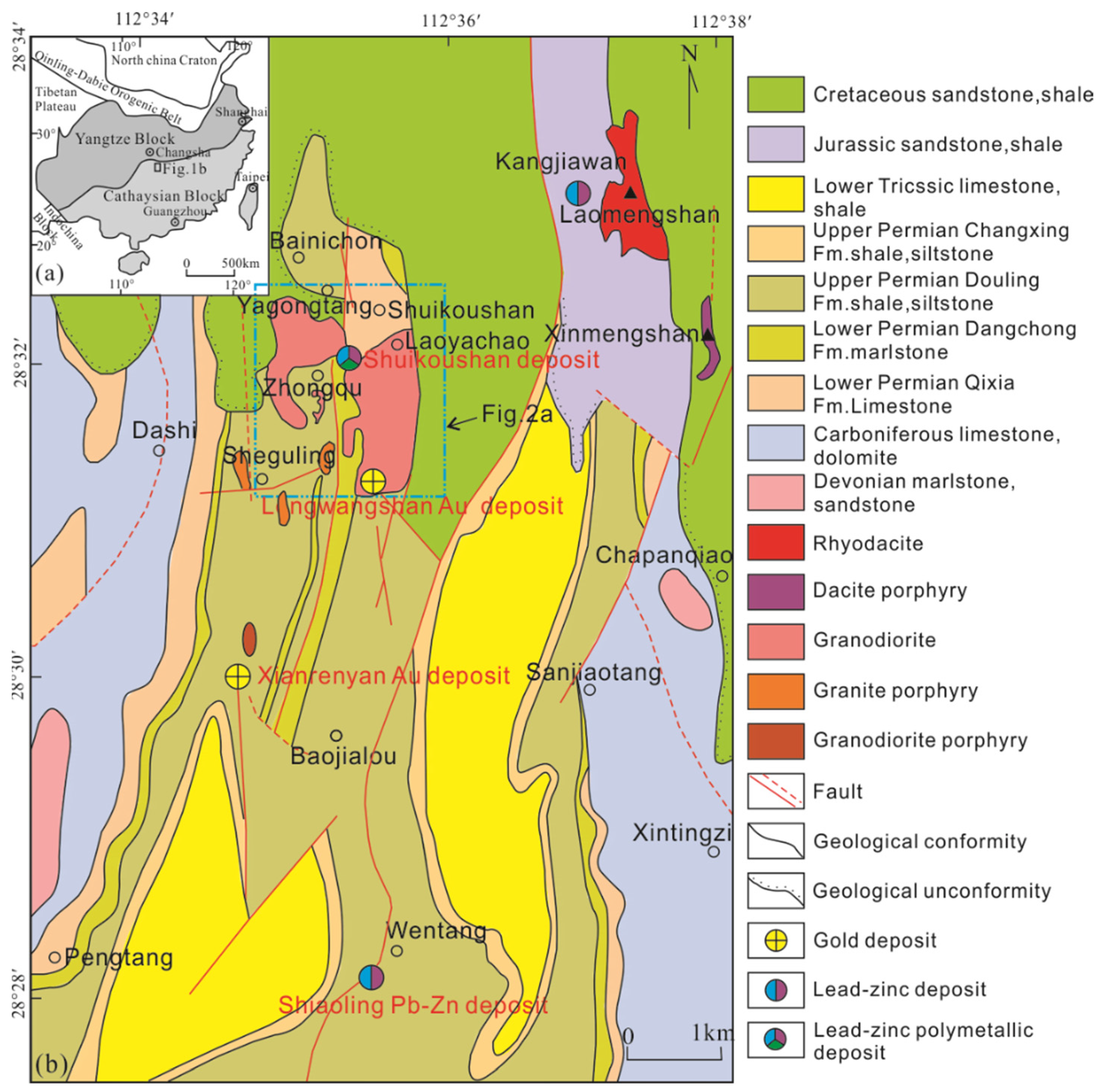
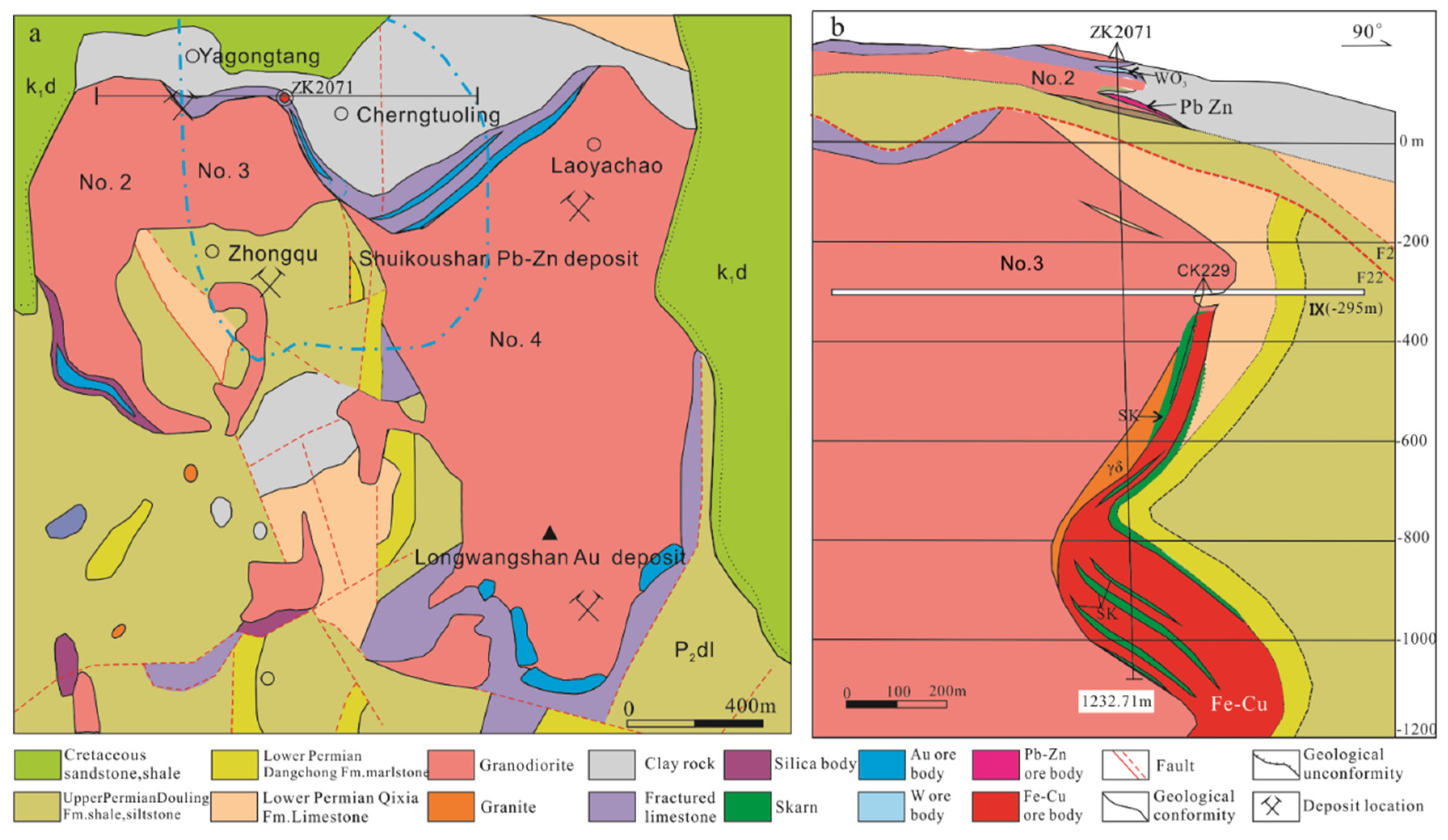
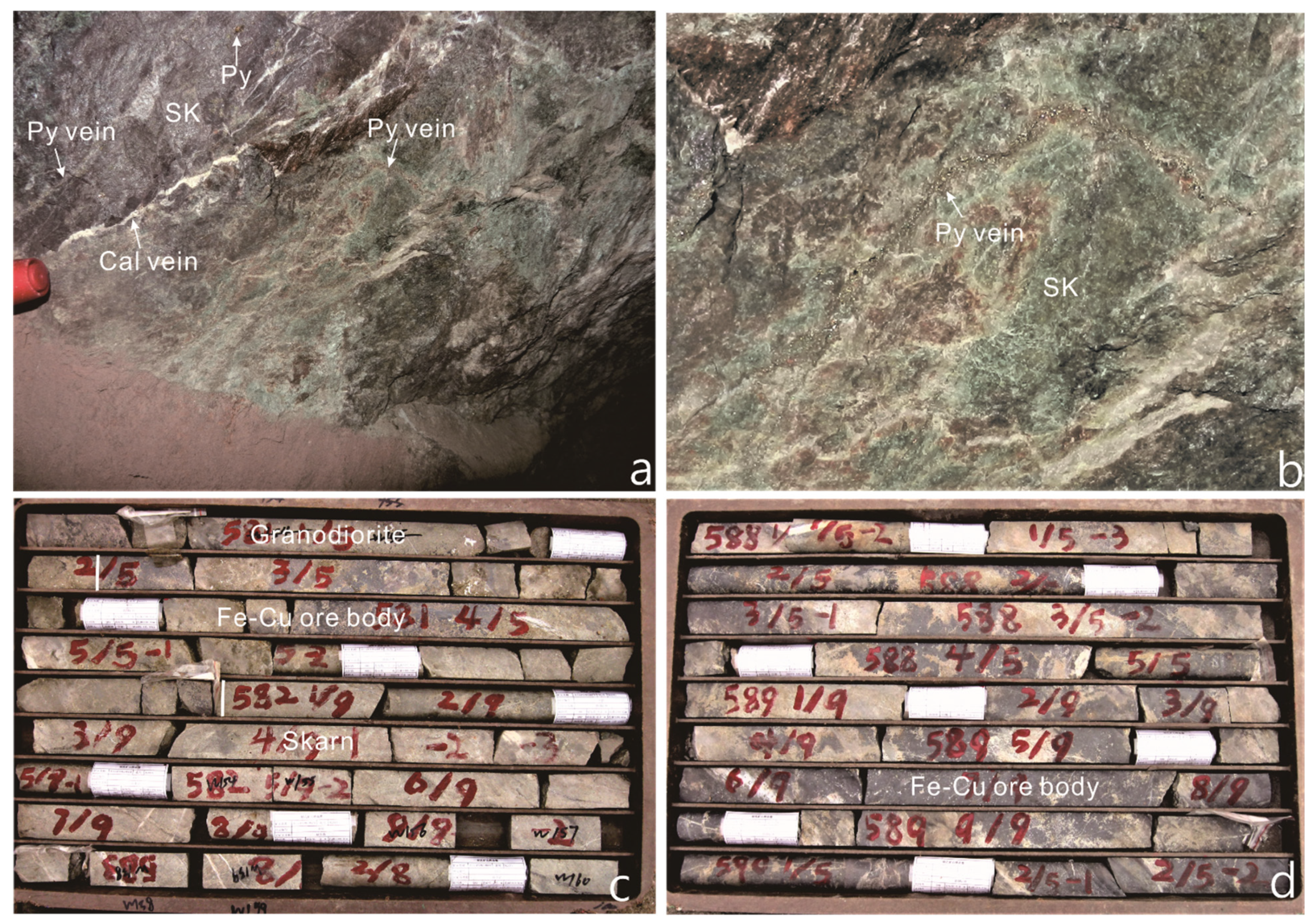
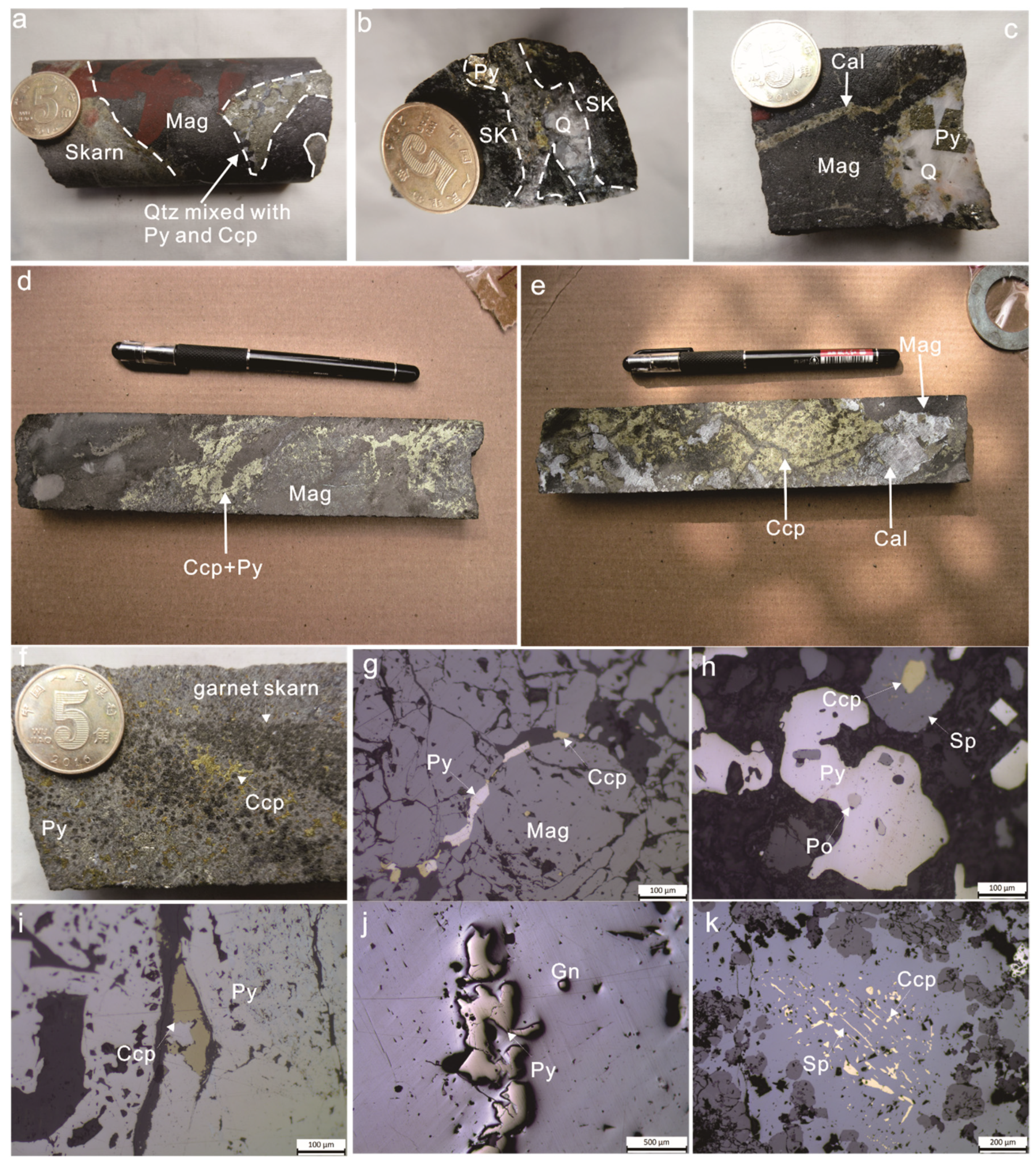
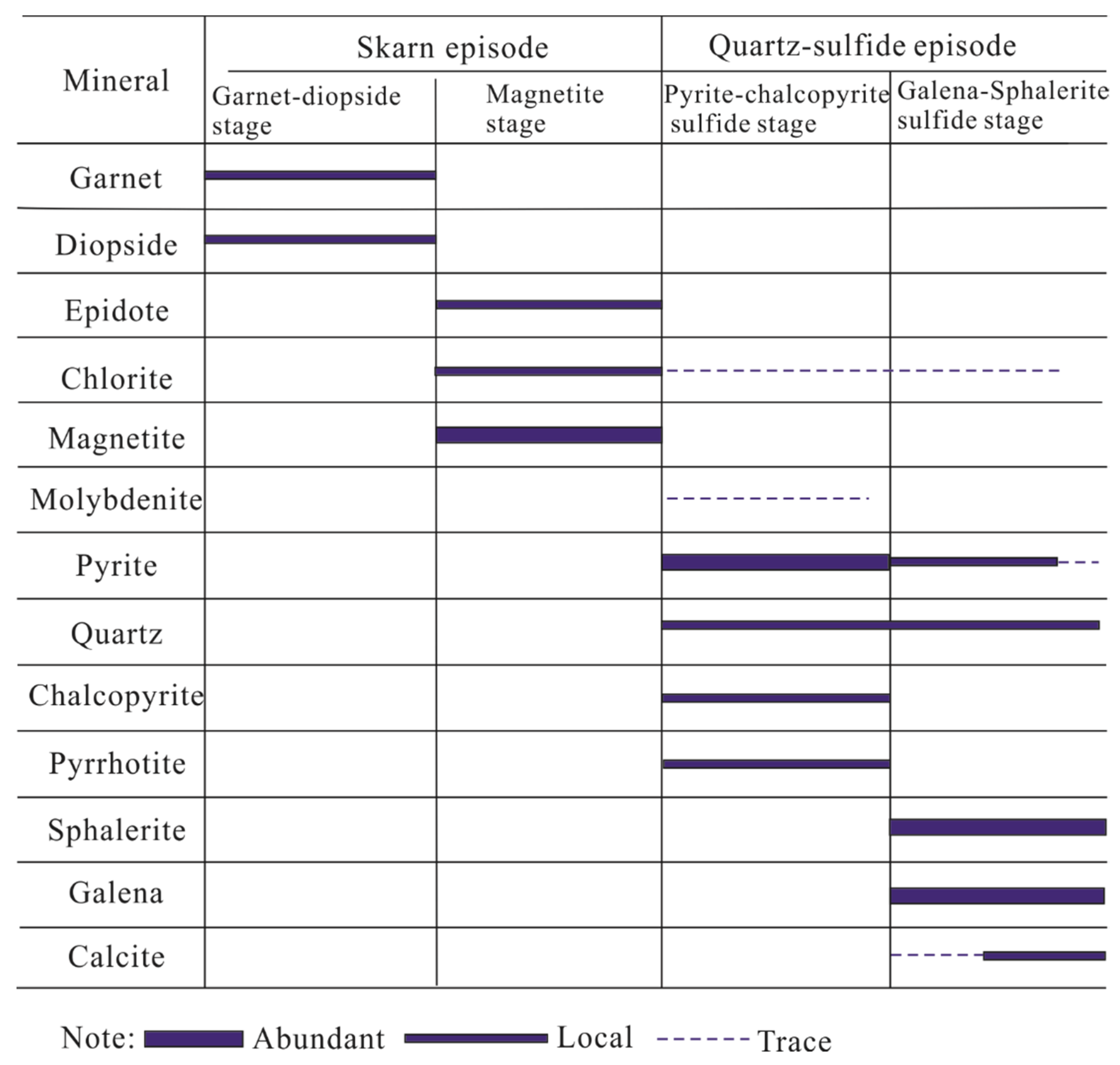
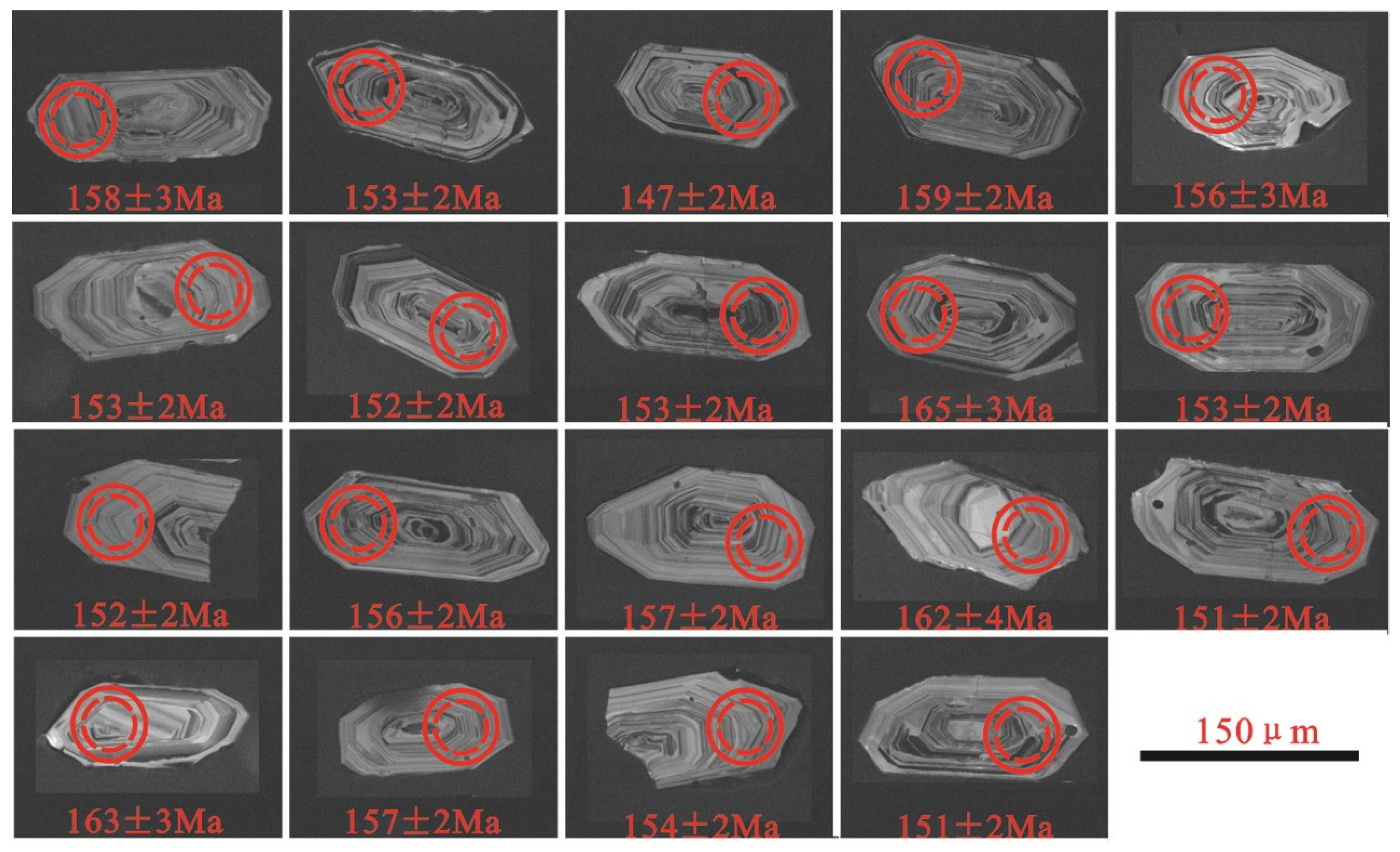
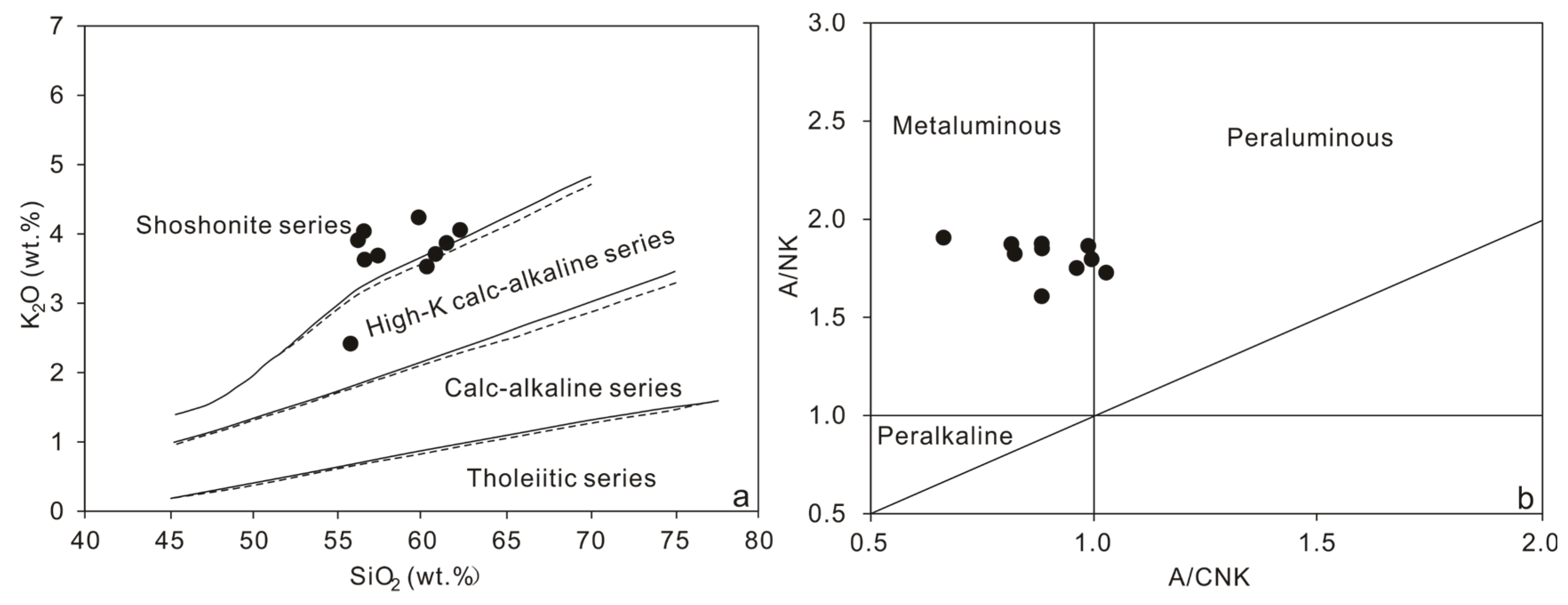


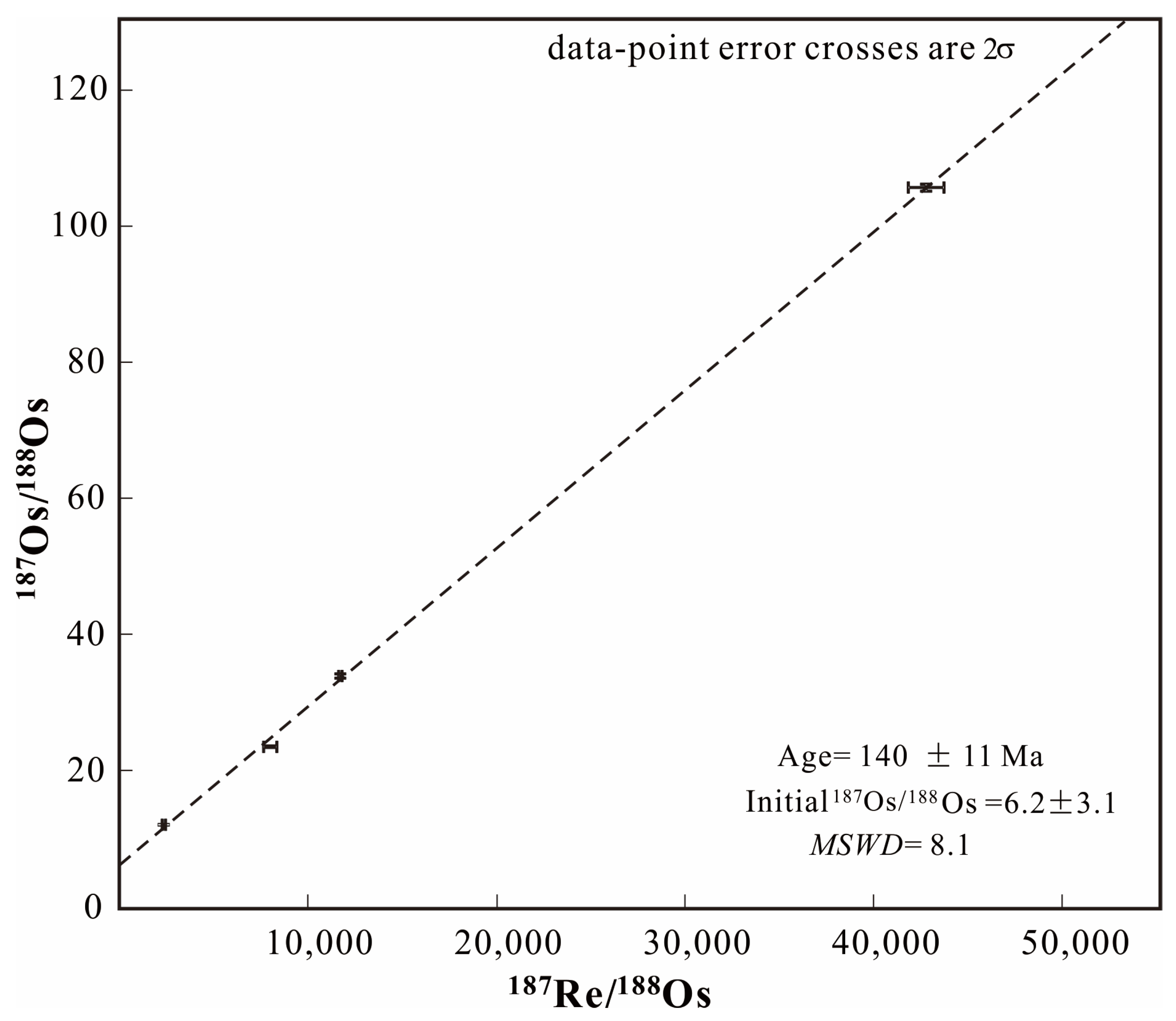
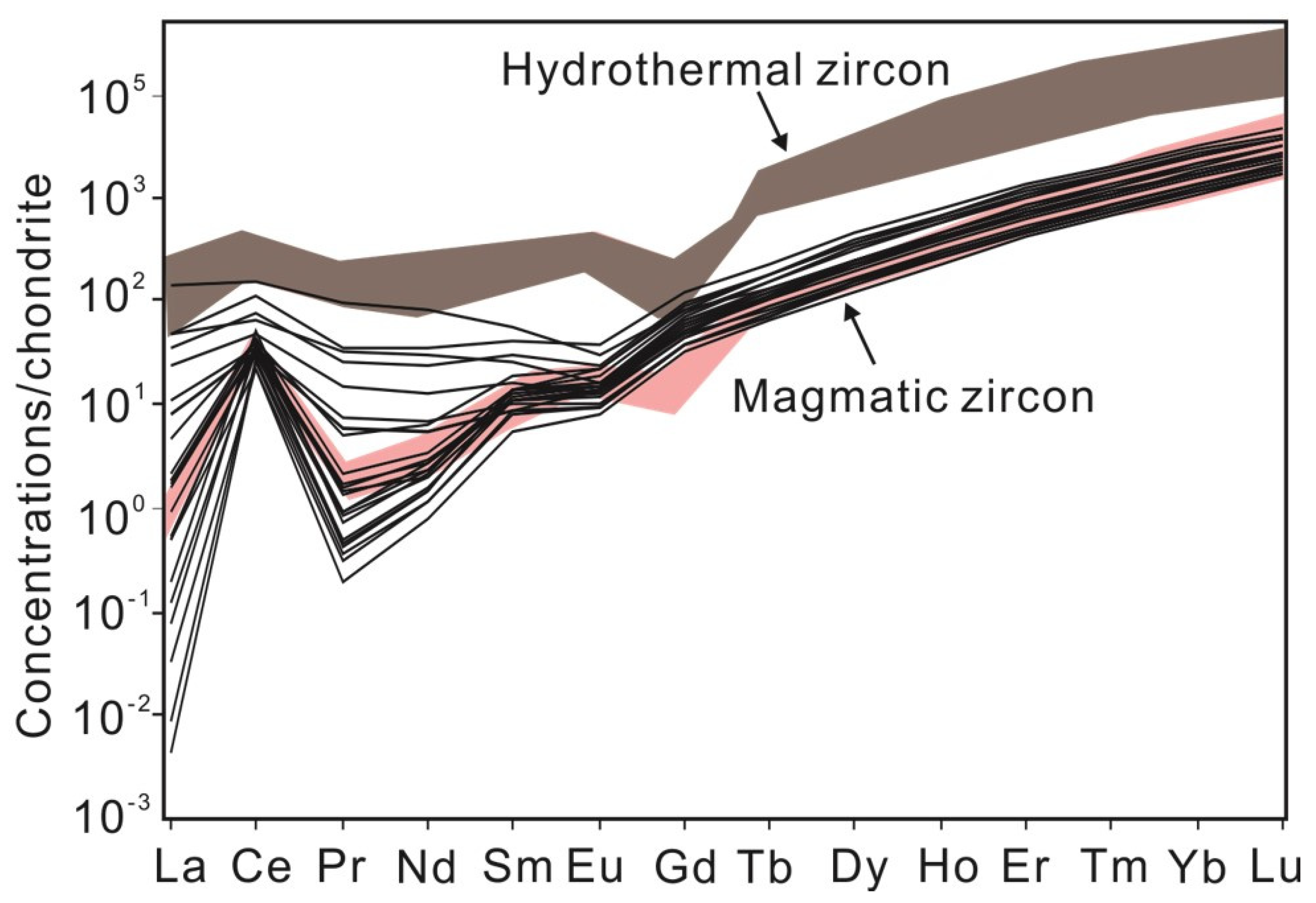

| Intrusions | Rock | Mineral | Method | Age (Ma) | Reference |
|---|---|---|---|---|---|
| Yagongtang No. 4 | Granodiorite | Zircon | LA-ICP-MS U-Pb | 163 ± 2 | [1] |
| Yagongtang No. 3 | Granodiorite | Zircon | SHRIMP U-Pb | 156.33 ± 0.64 | [3] |
| Zhongqu | Granodiorite | Zircon | LA-ICP-MS U-Pb | 153.0 ± 0.9 | [8] |
| Zhongqu | Granodiorite | Zircon | LA-ICP-MS U-Pb | 156.0 ± 1.0 | [2] |
| Xianrenyan | Granodiorite | Zircon | LA-ICP-MS U-Pb | 156.09 ± 0.46 | [7] |
| Laoyachao | Granodiorite | Zircon | SIMS U–Pb | 158.8 ± 1.8 | [9] |
| Sample No. | Sample Descriptions | Sample Locations |
|---|---|---|
| ZK2071-1 | Massive pyrite-magnetite ore | Drill hole ZK2071-1@ 997.82 m |
| ZK2071-7 | Garnet skarn that contains disseminated chalcopyrite and pyrite | Drill hole ZK2071-1@ 1094.8 m |
| ZK2071-8 | Massive chalcopyrite-pyrite-magnetite ore | Drill hole ZK2071-1@ 1089.9 m |
| ZK2071-10 | Massive pyrite-magnetite ore | Drill hole ZK2071-1@ 1070 m |
| ZK2071-11 | Magnetite ore that contains pyrite-quartz veins | Drill hole ZK2071-1@ 1199 m |
| Sample No. | ZK2001-1 | ZK2001-2 | ZK2001-3 | ZK2001-4 | ZK2001-5 | ZK2001-6 | ZK2001-7 | ZK2001-8 | ZK2001-9 | ZK2001-10 |
|---|---|---|---|---|---|---|---|---|---|---|
| SiO2 | 57.41 | 56.57 | 56.62 | 62.29 | 55.78 | 56.23 | 60.83 | 60.31 | 59.83 | 61.48 |
| Al2O3 | 16.04 | 17.61 | 16.28 | 15.72 | 15.76 | 16.98 | 15.98 | 16.01 | 15.52 | 15.86 |
| TFeO | 7.62 | 7.31 | 7.67 | 6.42 | 7.82 | 7.38 | 7.07 | 7.56 | 6.3 | 6.55 |
| CaO | 5.89 | 5.81 | 5.3 | 3.42 | 8.51 | 6.47 | 3.95 | 4.2 | 4.36 | 4.1 |
| MgO | 3.28 | 2.91 | 3.53 | 2.37 | 3.85 | 3.51 | 2.48 | 2.47 | 2.49 | 2.44 |
| Na2O | 2.91 | 3.04 | 2.95 | 2.85 | 3.43 | 2.93 | 2.96 | 2.89 | 3.07 | 2.95 |
| K2O | 3.69 | 4.04 | 3.63 | 4.06 | 2.42 | 3.91 | 3.71 | 3.53 | 4.24 | 3.87 |
| Cr2O3 | 0.01 | 0.02 | 0.01 | 0.01 | 0.01 | 0.01 | 0.01 | 0.01 | 0.01 | 0.01 |
| TiO2 | 0.95 | 1.13 | 1.14 | 0.64 | 0.53 | 1.12 | 0.68 | 0.71 | 0.66 | 0.67 |
| MnO | 0.13 | 0.12 | 0.12 | 0.12 | 0.19 | 0.15 | 0.13 | 0.16 | 0.15 | 0.14 |
| P2O5 | 0.41 | 0.38 | 0.44 | 0.33 | 0.41 | 0.41 | 0.35 | 0.41 | 0.34 | 0.36 |
| SrO | 0.08 | 0.09 | 0.07 | 0.06 | 0.08 | 0.09 | 0.07 | 0.06 | 0.06 | 0.07 |
| BaO | 0.1 | 0.11 | 0.1 | 0.08 | 0.05 | 0.11 | 0.08 | 0.07 | 0.09 | 0.1 |
| LOI * | 0.99 | 0.79 | 2.28 | 1.36 | 1.09 | 1.08 | 1.33 | 1.87 | 2.77 | 1.16 |
| Total | 99.51 | 99.93 | 100.14 | 99.73 | 99.93 | 100.38 | 99.63 | 100.26 | 99.89 | 99.76 |
| A/CNK ** | 0.82 | 0.88 | 0.88 | 1.03 | 0.66 | 0.81 | 0.99 | 0.99 | 0.88 | 0.96 |
| A/NK *** | 1.82 | 1.88 | 1.85 | 1.73 | 1.91 | 1.87 | 1.80 | 1.86 | 1.61 | 1.75 |
| Rb | 126.5 | 145.5 | 128.5 | 149 | 86.3 | 144 | 140.5 | 137.5 | 152 | 134 |
| Sr | 717 | 834 | 603 | 602 | 708 | 794 | 636 | 625 | 534 | 661 |
| Y | 22.9 | 20.6 | 20.9 | 22.7 | 32.8 | 22.6 | 24.2 | 27.8 | 24 | 23.3 |
| Zr | 189 | 210 | 232 | 165 | 131 | 197 | 178 | 177 | 177 | 173 |
| Nb | 9.8 | 10.6 | 12.7 | 12.8 | 5.8 | 10.3 | 13.7 | 14.8 | 13.3 | 13.3 |
| Ba | 896 | 954 | 795 | 755 | 423 | 952 | 743 | 671 | 750 | 832 |
| La | 37.2 | 39.1 | 40.3 | 44.9 | 41.8 | 39.8 | 44.2 | 50 | 40.4 | 40.5 |
| Ce | 74.2 | 76.4 | 79.1 | 85.4 | 89.7 | 78.7 | 85.6 | 98.9 | 81.8 | 80.6 |
| Pr | 8.6 | 8.8 | 8.83 | 9.46 | 10.7 | 9.09 | 9.7 | 11.3 | 9.69 | 9.29 |
| Nd | 33.1 | 33.8 | 34.7 | 36.3 | 43.3 | 35.7 | 37.9 | 44 | 37.8 | 36.4 |
| Sm | 6.15 | 6.41 | 6.2 | 7.29 | 8.69 | 7.08 | 7.52 | 8.61 | 7.61 | 7.12 |
| Eu | 1.68 | 1.8 | 1.6 | 1.63 | 2.26 | 1.75 | 1.7 | 1.93 | 1.7 | 1.72 |
| Gd | 5.14 | 4.87 | 5.19 | 5.22 | 6.77 | 5.26 | 5.69 | 6.95 | 5.62 | 5.54 |
| Tb | 0.76 | 0.69 | 0.71 | 0.8 | 1.05 | 0.76 | 0.82 | 0.98 | 0.81 | 0.77 |
| Dy | 4.25 | 3.86 | 4.04 | 4.26 | 6.16 | 4.42 | 4.53 | 5.36 | 4.51 | 4.58 |
| Ho | 0.85 | 0.77 | 0.75 | 0.86 | 1.26 | 0.86 | 0.89 | 1.04 | 0.93 | 0.92 |
| Er | 2.49 | 2.08 | 2.09 | 2.28 | 3.52 | 2.42 | 2.46 | 2.89 | 2.48 | 2.4 |
| Tm | 0.37 | 0.31 | 0.31 | 0.32 | 0.52 | 0.36 | 0.36 | 0.43 | 0.37 | 0.36 |
| Yb | 2.31 | 2.04 | 2.08 | 2.07 | 3.45 | 2.29 | 2.38 | 2.65 | 2.42 | 2.32 |
| Lu | 0.36 | 0.31 | 0.32 | 0.34 | 0.52 | 0.35 | 0.36 | 0.39 | 0.34 | 0.34 |
| Hf | 5.8 | 6 | 6.7 | 4.8 | 4.1 | 5.8 | 5.6 | 5.3 | 5.5 | 5.4 |
| Ta | 0.7 | 0.8 | 0.9 | 0.9 | 0.9 | 0.8 | 1.1 | 1.1 | 1 | 1 |
| Th | 10.5 | 10.25 | 10.75 | 12.25 | 7.29 | 9.39 | 12.5 | 13.05 | 13.8 | 13.35 |
| Y | 22.9 | 20.6 | 20.9 | 22.7 | 32.8 | 22.6 | 24.2 | 27.8 | 24 | 23.3 |
| ∑LREE **** | 160.93 | 166.31 | 170.73 | 184.98 | 196.45 | 172.12 | 186.62 | 214.74 | 179 | 175.63 |
| ∑HREE ***** | 39.43 | 35.53 | 36.39 | 38.85 | 56.05 | 39.32 | 41.69 | 48.49 | 41.48 | 40.53 |
| ∑REE ****** | 200.36 | 201.84 | 207.12 | 223.83 | 252.5 | 211.44 | 228.31 | 263.23 | 220.48 | 216.16 |
| Eu/Eu* | 0.91 | 0.98 | 0.86 | 0.81 | 0.90 | 0.88 | 0.79 | 0.76 | 0.79 | 0.84 |
| Ce/Ce* | 1.15 | 1.14 | 1.15 | 1.15 | 1.15 | 1.13 | 1.14 | 1.15 | 1.14 | 1.14 |
| No. | Ti | La | Ce | Pr | Nd | Sm | Eu | Gd | Tb | Dy | Ho | Er | Tm | Yb | Lu |
|---|---|---|---|---|---|---|---|---|---|---|---|---|---|---|---|
| 01 | 3.228 | 0.435 | 24.556 | 0.131 | 1.099 | 2.132 | 0.888 | 12.121 | 4.345 | 56.862 | 23.603 | 118.003 | 28.113 | 293.487 | 65.303 |
| 02 | 5.482 | 0.120 | 13.058 | 0.029 | 0.535 | 1.284 | 0.771 | 9.983 | 4.093 | 58.119 | 25.590 | 134.226 | 33.215 | 348.903 | 78.947 |
| 03 | 3.114 | 0.047 | 30.350 | 0.069 | 0.981 | 2.110 | 0.935 | 13.597 | 4.603 | 57.778 | 23.340 | 113.556 | 27.376 | 285.894 | 63.469 |
| 04 | 3.474 | 0.002 | 16.368 | 0.043 | 0.659 | 2.041 | 0.960 | 14.704 | 5.646 | 76.613 | 32.702 | 168.069 | 40.053 | 425.247 | 93.043 |
| 05 | 2.860 | 0.130 | 21.395 | 0.084 | 1.097 | 1.811 | 0.842 | 10.957 | 4.012 | 53.452 | 22.320 | 114.337 | 27.836 | 296.059 | 67.230 |
| 06 | 2.983 | 11.461 | 41.310 | 3.062 | 14.161 | 3.774 | 0.901 | 9.836 | 3.113 | 37.137 | 15.103 | 75.570 | 18.219 | 195.684 | 43.690 |
| 07 | 3.848 | 0.516 | 27.970 | 0.205 | 1.540 | 2.154 | 1.129 | 15.351 | 5.916 | 79.187 | 33.152 | 170.919 | 40.363 | 423.611 | 93.754 |
| 08 | 1.576 | 0.018 | 22.718 | 0.041 | 0.671 | 2.114 | 1.266 | 17.297 | 6.730 | 93.315 | 38.839 | 198.954 | 46.658 | 482.166 | 103.850 |
| 09 | 3.197 | 1.971 | 19.169 | 0.578 | 2.465 | 1.335 | 0.538 | 7.533 | 2.697 | 38.545 | 16.047 | 83.095 | 20.693 | 225.309 | 49.877 |
| 10 | 45.200 | 33.614 | 94.123 | 8.816 | 37.429 | 8.301 | 1.710 | 16.953 | 4.759 | 57.484 | 22.899 | 114.241 | 26.618 | 281.604 | 62.346 |
| 11 | 3.994 | 0.404 | 19.713 | 0.135 | 0.959 | 1.676 | 0.793 | 10.890 | 4.259 | 54.364 | 22.683 | 115.100 | 27.815 | 297.425 | 65.906 |
| 12 | 4.927 | 0.424 | 20.988 | 0.160 | 1.254 | 1.635 | 0.768 | 10.380 | 3.750 | 48.152 | 20.093 | 99.709 | 24.157 | 256.117 | 56.331 |
| 13 | 0.966 | 5.778 | 29.464 | 1.367 | 6.075 | 2.506 | 0.724 | 8.894 | 3.265 | 39.596 | 16.176 | 81.162 | 19.866 | 209.479 | 47.256 |
| 14 | 0.206 | 0.008 | 13.712 | 0.019 | 0.377 | 0.806 | 0.466 | 6.418 | 2.433 | 30.203 | 12.970 | 68.028 | 16.608 | 180.337 | 41.119 |
| 15 | 0.660 | 0.029 | 20.154 | 0.048 | 0.722 | 1.654 | 0.803 | 11.111 | 4.045 | 52.367 | 22.040 | 112.704 | 27.207 | 286.627 | 63.530 |
| 16 | 2.931 | 1.131 | 24.220 | 0.490 | 3.082 | 2.868 | 1.303 | 17.629 | 6.620 | 86.960 | 35.724 | 177.957 | 41.700 | 422.506 | 90.524 |
| 17 | 2.210 | 0.001 | 16.142 | 0.035 | 0.555 | 1.242 | 0.559 | 7.652 | 2.834 | 35.945 | 15.010 | 77.154 | 18.843 | 203.044 | 46.329 |
| 18 | 2.438 | 0.224 | 18.914 | 0.083 | 0.937 | 1.649 | 0.676 | 8.986 | 3.266 | 41.852 | 17.777 | 90.109 | 21.785 | 235.543 | 53.203 |
| 19 | 4.308 | 11.043 | 66.485 | 3.389 | 16.419 | 6.226 | 2.111 | 24.537 | 8.610 | 111.155 | 45.426 | 223.852 | 51.774 | 542.977 | 116.546 |
| No. | 204Pb | Pb | Th | U | Th/U | Isotope Ratios | Age (Ma) | |||||||
|---|---|---|---|---|---|---|---|---|---|---|---|---|---|---|
| (ppm) | 206Pb/204Pb ± 1σ * | 207Pb/204Pb ± 1σ | 208Pb/204Pb ± 1σ | 207Pb/206Pb ± 1σ | 207Pb/235U ± 1σ | 206Pb/238U ± 1σ | 206Pb/238U ± 1σ | 207Pb/235U ± 1σ | 207Pb/206Pb ± 1σ | |||||
| 01 | 0.2299 | 12 | 284 | 353 | 0.80 | 162.5541 ± 3.1165 | 8.6963 ± 0.2343 | 19.8415 ± 0.5228 | 0.0493 ± 0.0017 | 0.1693 ± 0.0059 | 0.0248 ± 0.0004 | 158 ± 3 | 159 ± 5 | 161 ± 81 |
| 02 | 0.0000 | 8 | 120 | 271 | 0.44 | - | - | - | 0.0506 ± 0.0023 | 0.1682 ± 0.0077 | 0.0240 ± 0.0004 | 153 ± 2 | 158 ± 7 | 233 ± 109 |
| 03 | 0.6346 | 17 | 488 | 518 | 0.94 | 81.5192 ± 3.6454 | 4.3675 ± 0.2573 | 11.0434 ± 0.5998 | 0.0492 ± 0.0015 | 0.1577 ± 0.0047 | 0.0231 ± 0.0003 | 147 ± 2 | 149 ± 4 | 167 ± 70 |
| 04 | 0.3761 | 12 | 205 | 378 | 0.54 | 105.8367 ± 4.5492 | 5.8363 ± 0.2982 | 8.537 ± 0.3813 | 0.0511 ± 0.0020 | 0.1749 ± 0.0066 | 0.0249 ± 0.0003 | 159 ± 2 | 164 ± 6 | 256 ± 82 |
| 05 | 0.0000 | 10 | 233 | 305 | 0.76 | - | - | - | 0.0484 ± 0.0021 | 0.1614 ± 0.0070 | 0.0245 ± 0.0004 | 156 ± 3 | 152 ± 6 | 120 ± 104 |
| 06 | 0.0000 | 7 | 162 | 230 | 0.70 | - | - | - | 0.0476 ± 0.0019 | 0.1559 ± 0.0058 | 0.0241 ± 0.0004 | 153 ± 2 | 147 ± 5 | 80 ± 96 |
| 07 | 0.4531 | 13 | 312 | 408 | 0.76 | 91.6916 ± 4.3939 | 4.9962 ± 0.2996 | 9.9324 ± 0.6416 | 0.0497 ± 0.0016 | 0.1650 ± 0.0058 | 0.0239 ± 0.0003 | 152 ± 2 | 155 ± 5 | 189 ± 76 |
| 08 | 0.3113 | 18 | 340 | 561 | 0.61 | 186.0025 ± 8.8115 | 10.2026 ± 0.5346 | 17.5394 ± 0.9812 | 0.0499 ± 0.0014 | 0.1659 ± 0.0047 | 0.0241 ± 0.0003 | 153 ± 2 | 156 ± 4 | 191 ± 65 |
| 09 | 1.0317 | 8 | 139 | 231 | 0.60 | 25.3724 ± 1.5253 | 1.5284 ± 0.216 | 2.3369 ± 0.3063 | 0.0545 ± 0.0030 | 0.1948 ± 0.0109 | 0.0260 ± 0.0005 | 165 ± 3 | 181 ± 9 | 391 ± 122 |
| 10 | 0.5950 | 11 | 285 | 350 | 0.81 | 60.2182 ± 2.1858 | 3.6562 ± 0.228 | 7.5177 ± 0.3599 | 0.0547 ± 0.0020 | 0.1805 ± 0.0064 | 0.0241 ± 0.0004 | 153 ± 2 | 169 ± 6 | 398 ± 79 |
| 11 | 0.6327 | 12 | 264 | 387 | 0.68 | 62.1847 ± 3.2604 | 3.3457 ± 0.2432 | 6.1415 ± 0.3878 | 0.0492 ± 0.0017 | 0.1626 ± 0.0057 | 0.0239 ± 0.0003 | 152 ± 2 | 153 ± 5 | 167 ± 80 |
| 12 | 0.0000 | 10 | 244 | 313 | 0.78 | - | - | - | 0.0500 ± 0.0018 | 0.1709 ± 0.0066 | 0.0245 ± 0.0004 | 156 ± 2 | 160 ± 6 | 195 ± 83 |
| 13 | 0.0000 | 9 | 216 | 278 | 0.78 | - | - | - | 0.0504 ± 0.0018 | 0.1725 ± 0.0064 | 0.0246 ± 0.0004 | 157 ± 2 | 162 ± 6 | 217 ± 85 |
| 14 | 0.0000 | 6 | 108 | 195 | 0.55 | - | - | - | 0.0553 ± 0.0038 | 0.1925 ± 0.0116 | 0.0255 ± 0.0006 | 162 ± 4 | 179 ± 10 | 433 ± 152 |
| 15 | 0.7167 | 10 | 241 | 335 | 0.72 | 46.9730 ± 2.6036 | 2.6454 ± 0.2306 | 5.0501 ± 0.3424 | 0.0503 ± 0.0016 | 0.1627 ± 0.0048 | 0.0237 ± 0.0004 | 151 ± 2 | 153 ± 4 | 206 ± 74 |
| 16 | 0.8753 | 12 | 302 | 379 | 0.80 | 44.8390 ± 6.9567 | 2.3401 ± 0.3906 | 5.0659 ± 1.0803 | 0.0478 ± 0.0023 | 0.1685 ± 0.0079 | 0.0256 ± 0.0004 | 163 ± 3 | 158 ± 7 | 100 ± 98 |
| 17 | 0.0000 | 8 | 172 | 258 | 0.67 | - | - | - | 0.0507 ± 0.0019 | 0.1732 ± 0.0063 | 0.0247 ± 0.0004 | 157 ± 2 | 162 ± 5 | 228 ± 85 |
| 18 | 0.6845 | 9 | 202 | 274 | 0.74 | 41.9192 ± 2.0682 | 2.3646 ± 0.176 | 4.4998 ± 0.2917 | 0.0509 ± 0.0019 | 0.1705 ± 0.0064 | 0.0242 ± 0.0003 | 154 ± 2 | 160 ± 6 | 235 ± 85 |
| 19 | 0.3204 | 20 | 567 | 614 | 0.92 | 194.2122 ± 5.4401 | 10.5787 ± 0.3844 | 25.6603 ± 0.913 | 0.0490 ± 0.0012 | 0.1611 ± 0.0105 | 0.0237 ± 0.0003 | 151 ± 2 | 152 ± 4 | 150 ± 53 |
| No. | Age (Ma) | 176Yb/177Hf | 2σ | 176Lu/177Hf | 2σ | 176Hf/177Hf | 2σ | 178Hf/177Hf | 2σ | εHf(t) | TDM2 (Ma) |
|---|---|---|---|---|---|---|---|---|---|---|---|
| 01 | 158 | 0.043373 | 0.000140 | 0.001518 | 0.000006 | 0.282481 | 0.000012 | 1.46793 | 0.00004 | −7.0 | 1644 |
| 02 | 153 | 0.046387 | 0.000409 | 0.001656 | 0.000008 | 0.282460 | 0.000012 | 1.46776 | 0.00003 | −7.8 | 1694 |
| 03 | 147 | 0.038990 | 0.000131 | 0.001389 | 0.000004 | 0.282451 | 0.000009 | 1.46786 | 0.00003 | −8.3 | 1715 |
| 04 | 159 | 0.044439 | 0.000186 | 0.001545 | 0.000003 | 0.282406 | 0.000011 | 1.46785 | 0.00003 | −9.6 | 1809 |
| 05 | 156 | 0.047420 | 0.000154 | 0.001629 | 0.000008 | 0.282437 | 0.000010 | 1.46782 | 0.00003 | −8.6 | 1743 |
| 06 | 153 | 0.035784 | 0.000142 | 0.001210 | 0.000004 | 0.282459 | 0.000008 | 1.46779 | 0.00002 | −7.8 | 1693 |
| 07 | 152 | 0.043828 | 0.000373 | 0.001560 | 0.000012 | 0.282433 | 0.000009 | 1.46785 | 0.00003 | −8.8 | 1754 |
| 08 | 153 | 0.045697 | 0.000598 | 0.001607 | 0.000017 | 0.282414 | 0.000010 | 1.46780 | 0.00003 | −9.5 | 1795 |
| 09 | 165 | 0.057360 | 0.000492 | 0.001714 | 0.000011 | 0.282427 | 0.000011 | 1.46781 | 0.00003 | −8.8 | 1761 |
| 10 | 153 | 0.048127 | 0.000220 | 0.001528 | 0.000010 | 0.282435 | 0.000010 | 1.46779 | 0.00003 | −8.7 | 1748 |
| 11 | 152 | 0.037208 | 0.000183 | 0.001202 | 0.000009 | 0.282460 | 0.000011 | 1.46784 | 0.00003 | −7.8 | 1692 |
| 12 | 156 | 0.046840 | 0.000210 | 0.001515 | 0.000005 | 0.282457 | 0.000008 | 1.46776 | 0.00002 | −7.9 | 1698 |
| 13 | 157 | 0.053740 | 0.000457 | 0.001555 | 0.000018 | 0.282462 | 0.000009 | 1.46778 | 0.00002 | −7.7 | 1687 |
| 14 | 162 | 0.017525 | 0.000212 | 0.000627 | 0.000006 | 0.281848 | 0.000012 | 1.46785 | 0.00003 | −29.2 | 3023 |
| 15 | 151 | 0.053747 | 0.000232 | 0.001729 | 0.000006 | 0.282457 | 0.000008 | 1.46781 | 0.00003 | −8.0 | 1702 |
| 16 | 163 | 0.044762 | 0.000240 | 0.001482 | 0.000012 | 0.282435 | 0.000009 | 1.46777 | 0.00003 | −8.5 | 1743 |
| 17 | 157 | 0.039111 | 0.000178 | 0.001440 | 0.000006 | 0.282457 | 0.000009 | 1.46779 | 0.00003 | −7.8 | 1697 |
| 18 | 154 | 0.035516 | 0.000273 | 0.001108 | 0.000004 | 0.282438 | 0.000008 | 1.46782 | 0.00002 | −8.5 | 1739 |
| 19 | 151 | 0.048764 | 0.000224 | 0.001539 | 0.000006 | 0.282418 | 0.000008 | 1.46777 | 0.00002 | −9.4 | 1787 |
| Sample No. | Re (ppb) | Os (ppb) | 187Os/188Os | 187Re/188Os | ||||
|---|---|---|---|---|---|---|---|---|
| Value | Uncertainty (2σ) | Value | Uncertainty (2σ) | Value | Uncertainty (2σ) | Value | Uncertainty (2σ) | |
| ZK2071-1 | 26.898 | 0.562 | 0.0448 | 0.00032 | 105.64 | 0.52 | 42,709 | 943 |
| ZK2071-7 | 11.001 | 0.413 | 0.05748 | 0.0001 | 12.21 | 0.04 | 2375 | 89 |
| ZK2071-8 | 22.23 | 0.145 | 0.04949 | 0.00021 | 33.97 | 0.3 | 11,718 | 91 |
| ZK2071-10 | 13.155 | 0.576 | 0.03216 | 0.00011 | 23.61 | 0.12 | 8009 | 352 |
| ZK2071-11 | 5.632 | 0.125 | 0.03028 | 0.00006 | 9.79 | 0.04 | 2026 | 45 |
| Type | Deposit | Rock | Mineral | Method | Age (Ma) | Reference |
|---|---|---|---|---|---|---|
| Host intrusions | Huanshaping Pb-Zn deposit | Granite | Zircon | LA-ICP-MS U-Pb | 158.5 ± 0.9, 155.2 ± 0.4 160.8 ± 1.0 | [19] |
| Quartz porphyry | Zircon | SHRIMP U-Pb | 152 ± 3 | [71] | ||
| Baoshan Pb-Zn deposit | Granodiorite porphyry | Zircon | LA-ICP-MS | 156~158 | [72] | |
| Granodiorite porphyry and skarn | Zircon | SHRIMP U-Pb | 158 ± 2 | [35] | ||
| Tongshanling polymetallic ore field | Granitic diorite | Zircon | SHRIMP U-Pb, Sm-Nd isochron | 157 ± 2 155 ± 8 | [73] | |
| Hongqiling Sn polymetallic deposit | The quartz vein type wolframite | Muscovite | 40Ar-39Ar isochron | 153.6 ± 1.5 | [18] | |
| Yaogangxian W polymetallic ore deposit | Biotite granite, porphyritic granite and quartz porphyry | Zircon | SHRIMP U-Pb | 155.4 ± 2.2 157.6 ± 2.6 158.4 ± 2.1 | [74] | |
| Furong Sn deposit | Hornblende granite | Muscovite/Biotite | 40Ar-39Ar isochron | 157.5 ± 0.3, 156.1 ± 0.4, 160.1 ± 0.9 | [13,14] | |
| Skarn | Muscovite/ | 40Ar-39Ar isochron | 151–160 | [16] | ||
| Hornblende | ||||||
| Xianghualing Sn polymetallic ore deposit | Biotite granite | Zircon | LA-ICP-MS U-Pb | 160.7 ± 2.2 | [75] | |
| Mineralization | Huanshaping Pb-Zn deposit | Skarn type ore | Molybdenite | Re-Os isochron | 154.8 ± 1.9 | [76] |
| Skarn type ore | Molybdenite | Re-Os isochron | 159.4 ± 3.3, 157.5 ± 2.4, 157.6 ± 2.3 | [71] | ||
| Baoshan Pb-Zn deposit | Granodiorite porphyry and skarn | Molybdenite | Re-Os isochron | 160 ± 2 | [35] | |
| Tongshanling Cu polymetallic ore field | Skarn ore body | Molybdenite | Re-Os isochron | 155 ± 3 | [73] | |
| Shizhuyuan W polymetallic deposit | Skarn ore bodies | Molybdenite | Re-Os isochron | 151.0 ± 3.5 | [12] | |
| Jinchuantang Sn-Bi deposit | Skarn type ore | Molybdenite | Re-Os isochron | 158.8 ± 6.6 | [17] | |
| Xintianling large W-Mo ore deposit | Skarn and quartz vein type ore | Molybdenite | Re-Os isochron | Skarn: 159.1 ± 2.6 | [18] | |
| Quartz vein type: 159.1–160.2 |
Publisher’s Note: MDPI stays neutral with regard to jurisdictional claims in published maps and institutional affiliations. |
© 2021 by the authors. Licensee MDPI, Basel, Switzerland. This article is an open access article distributed under the terms and conditions of the Creative Commons Attribution (CC BY) license (https://creativecommons.org/licenses/by/4.0/).
Share and Cite
Li, S.; Cao, Y.; Song, Z.; Xiao, D. Zircon U-Pb and Pyrite Re-Os Isotope Geochemistry of ‘Skarn-Type’ Fe-Cu Mineralization at the Shuikoushan Polymetallic Deposit, South China: Implications for an Early Cretaceous Mineralization Event in the Nanling Range. Minerals 2021, 11, 480. https://doi.org/10.3390/min11050480
Li S, Cao Y, Song Z, Xiao D. Zircon U-Pb and Pyrite Re-Os Isotope Geochemistry of ‘Skarn-Type’ Fe-Cu Mineralization at the Shuikoushan Polymetallic Deposit, South China: Implications for an Early Cretaceous Mineralization Event in the Nanling Range. Minerals. 2021; 11(5):480. https://doi.org/10.3390/min11050480
Chicago/Turabian StyleLi, Shengbin, Yonghua Cao, Zeyou Song, and Dan Xiao. 2021. "Zircon U-Pb and Pyrite Re-Os Isotope Geochemistry of ‘Skarn-Type’ Fe-Cu Mineralization at the Shuikoushan Polymetallic Deposit, South China: Implications for an Early Cretaceous Mineralization Event in the Nanling Range" Minerals 11, no. 5: 480. https://doi.org/10.3390/min11050480
APA StyleLi, S., Cao, Y., Song, Z., & Xiao, D. (2021). Zircon U-Pb and Pyrite Re-Os Isotope Geochemistry of ‘Skarn-Type’ Fe-Cu Mineralization at the Shuikoushan Polymetallic Deposit, South China: Implications for an Early Cretaceous Mineralization Event in the Nanling Range. Minerals, 11(5), 480. https://doi.org/10.3390/min11050480






